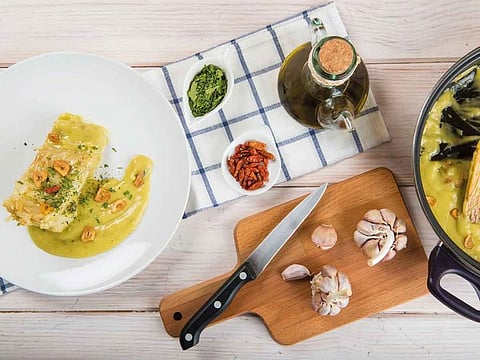Get ready for a unique journey through Spain’s delicious cuisine
Here’s your guide to explore the diverse flavours of Spanish cuisine

Current Spanish cuisine is the result of centuries of evolution, defined by its geographical characteristics and the country’s deep-rooted history. On the one hand, this translates into maximum quality and a large bounty of culinary raw materials, and on the other, the passage of the different people and civilizations through the Iberian Peninsula have left rich and varied influences on Spanish gastronomy — from the sauces introduced by the Phoenicians to the famous olive oil, inherited from the ancient Greeks. Did you know that Spanish gazpacho has Arabic roots? Now, without losing sight of its origins, Spain’s high-end cuisine also feeds off international cuisines, with dishes loaded with nuances and intelligent combinations.
The best-known Spanish cuisine outside its borders includes paella, gazpacho (cold vegetable soup), potato omelette, cocido madrileño (chickpeas stewed with meat), churros, and tapas. But there are many other traditional recipes on Spanish dinner tables. The main ingredients differ depending on the region. For instance, Murcia is known for its stews and garden vegetables are staples in this region’s recipes. Some michirones with cooked broad beans and chicken or turkey chorizo, meat and paprika, or olla gitana (chickpeas with potato and pumpkin) are traditional Spanish dishes that will warm you up on cold winter days.
If you love meat, Castilla y León is an essential destination. Galicia is known for using top-quality seafood in its original dishes. We’re talking about clams, mussels, scallops, and one of the most popular dishes, octopus, which is eaten either boiled with salt, Spanish paprika and olive oil, or served with cachelos (potatoes cooked with salt and bay leaf). On the Mediterranean coast, the main dishes include fresh fish which can be served baked, stewed, or grilled.
And to finish off, traditional Spanish cuisine has no shortage of desserts, such as tocinos de cielo, pestiños, crema catalana, sobaos, buñuelos, or tarta de Santiago. They are as delicious as they are sweet, since their main ingredients are flour, eggs, and sugar.
The county’s history, climate, and love of cooking have resulted in a wide variety of original Spanish dishes. And the best way of discovering this is to try them all. What would you like to try first?
TAPAS FROM SPAIN TO THE REST OF THE WORLD
Tapas are amongst the most cherished of Spain’s gastronomic traditions. Tapas have become a hallmark of the Spanish fare throughout the world and they are a delicious and surprising way to taste the country’s products.
If you visit Spain, you really have to try some tapas.
With over 70 years of history, tapas have become much more than a simple cuisine.
Tapas are small aperitifs you order before lunch and they are enjoyed in the company of family and friends.
One of the most common is a bite-size piece of Spanish omelette. You can ask for one in any bar.
The Basque Country is renowned for the tradition of eating based on pintxos. These are small finger foods, often called haute cuisine, and are typical of Basque gastronomy.
The fame of Spanish tapas has led to the establishment of World Tapas Day, which is hosted simultaneously in Spain and in other countries around the world on the third Thursday of June.
Spanish restaurants and chefs take advantage of this event to promote tapas, which are so typically Spanish. It is an ideal opportunity for enjoying signature tapas as well as learning more about the tapas culture through exhibitions and talks by some of the most renowned Spanish chefs.
Put World Tapas Day in your diary and maybe you’ll find a little piece of Spain somewhere near you.
Try this easy Spanish recipe during Ramadan
CACHOPO
SERVES 2
PREP TIME 15 MINS
COOKING TIME 20 MINS
DIFFICULTY Moderate
360g white veal
80g vidiago cheese
2 slices of cured beef
10g minced beef
1 egg
600g panko crumbs
200g breadcrumbs
200g flour
1 clove black garlic
2-3 tbsp mayonnaise
50ml Picual olive oil for the dip
100ml oil for frying
Method
For the Cachopo
1. Season the meat and the slices of beef with salt and pepper. Place minced beef and cheese on top of the meat and fold it in a way so that it is wrapped as a fillet. Then vacuum seal it.
2. Next, whisk the egg and season it. Mix panko crumbs, flour and breadcrumbs.
3. Pass the cachopo through the egg and cover it with the breadcrumbs. Pat it gently and shake off any excess crumb. Heat oil in a pan and fry it at 200° C until golden brown.
4. Once it is fried, drain again. Cut into pieces.
For the black garlic mayonnaise
1. Peel the garlic and crush it together with olive oil and mayonnaise in a Thermomix, so that it emulsifies with the Picual olive oil.
2. Serve cachopo with black garlic mayonnaise.
Recipe courtesy of Chef Iñigo Urrechu for Provacuno
Sign up for the Daily Briefing
Get the latest news and updates straight to your inbox


